-
Posts
2,616 -
Joined
-
Last visited
Content Type
Profiles
Forums
Store
Help Articles
Posts posted by Peter the eater
-
-
I've never had a good meal at the Waring House.
I've had several above average meals there, but that was seven or eight years ago.
-
Egg-in-the-hole is what my mother called it, I grew up in Ontario plus a little bit in Quebec.
-
I forgot to mention that it might be too soon for corn, but the spuds can be top drawer. PEI takes potatoes very seriously. There's even a potato museum in O'Leary, King's County.
-
I get to PEI a couple of times a year so I'm hardly qualified to offer local insider info. I can tell you that there's often a seafood truck behind the liquor store near the Charlottetown Airport that sells uber-fresh seafood -- razor clams, periwinkles, mussels, oysters, and/or whatever fish is available.
If you're in Cavendish then Malpeque Bay and it's excellent oysters are only 25km west.
Check out the Culinary Institute of Canada in downtown Charlottetown. You can do the half-day Seafood 101 Culinary Bootcamp for $129.
-
Absolutely, it's like a marine dried herb. It can be found at the store in small shakers to be used that way.
-
If you want an extreme experience Peter then it's in the preparation.
Thanks, Prawncrackers. My childhood memories of eel, unfortunately, are disturbing without the delicious. I caught one as a seven year old, right out of the Ottawa River then promptly showed my uncle. He shot it with a 22 then chucked it back in the river for the muskrats. Nobody ate eels in Upper Canada back in the 70's.
-
Today I was surprised and excited to see fresh eels at my regular grocery store. I had to pass since we're going away, but my mind is reeling with possibilities. I've had eel a few different ways now but what I'd really like is a preparation that showcases the extreme appearance.
Maybe stretched out and roasted on a long stick?
Planked on a 3' cedar fence board?
Coiled up like a kielbasa in the oven?
-
Sounds like an adventure. I like dry long pasta for travel -- nothing curvy or hollow. I figure something like capellini has the least amount of air space per package.
I enjoy dicing veggies and other things then vacuum-bagging them with a sauce. Depending on what you've got in the mix, it could be prepped 100% raw or fully cooked for a reheat, or somewhere in between.
Canned protein is a logical choice if the desire is low volume but weight's not a problem. Herring fillets, corned beef, even a canned ham might fit in the glove compartment.
-
Everybody should have some aluminum cookware in the kitchen. It's affordable, light weight, heat responsive, durable, 100% recyclable -- perfect for camping.
If you need a really, really big pot then aluminum is the answer. We make maple syrup in March using giant cauldrons made of aluminum. The use of cast iron would add hundreds of pounds and dollars.
Mgaretz is right on with the oxide, it accumulates on the surface in an additive and protective way. Iron, on the other hand, oxidizes (rusts) in a destructive way.
Here's what Health Canada says:
Canadians normally take in about 10 milligrams of aluminum daily, mostly from food. Aluminum pots and pans provide only one or two milligrams of the total. While aluminum has been associated with Alzheimer's disease, there is no definite link proven. The World Health Organization estimates that adults can consume more than 50 milligrams of aluminum daily without harm.During cooking, aluminum dissolves most easily from worn or pitted pots and pans. The longer food is cooked or stored in aluminum, the greater the amount that gets into food. Leafy vegetables and acidic foods, such as tomatoes and citrus products, absorb the most aluminum.
-
Molasses is a very important ingredient at my place -- I can't survive long without Crosby's from New Brunswick. Dark, thick, sweet, complex. So versatile.
-
Bob, your lamb bacon looks compelling. I've sampled mutton bacon and was very impressed, although I'm not sure what part of the animal was used. Yours was a saddle, no? It looks similar to my beloved sample but the color may have been different -- they used KNO3 and got a more pink result.
It certainly challenges the definition of bacon. Really, is there a mammal that can't yield bacon?
-
I'm pro-Triscuit.
Years ago I went through a phase where I bought nothing processed, and nothing from a box. During this time I discovered that some crackers are rather easy to make, but not so with Triscuits.
I now buy Triscuits for taste and convenience, and because they stand up so well to the broiler and the microwave.
-
How do the spiny lobsters of America compare to the spiny lobsters of Australia?
-
I like both. Our everyday table is the round one in the kitchen -- it's got a hard laminate top with a few chips and burns, so it usually has a cloth. I keep five or six in rotation, all two-sided and easily shaken outside. Our "fancy table" is a hundred and fifty years old and pretty rickety. It looks best with a few small placemats.
-
I just found the recipe here and the clay he uses is called kaolin.
Those look intriguing.
Kaolin is the kao- in kaopectate, medicine for diarrhoea.
-
Very interesting topic. Are you thinking of preparing recognizable meat portions, like a whole chicken with skin? The salt shell technique that jgm mentions can be very impressive.
Right, I see you're thinking shape'n'bake. How about making thin-shelled finished pottery pieces first, line them with a food-safe greasy barrier, then fill with pate batter and then bake? The delicate clay vessels could be whacked open with a spoon, at least in my imagination. How about a sugar shell?
-
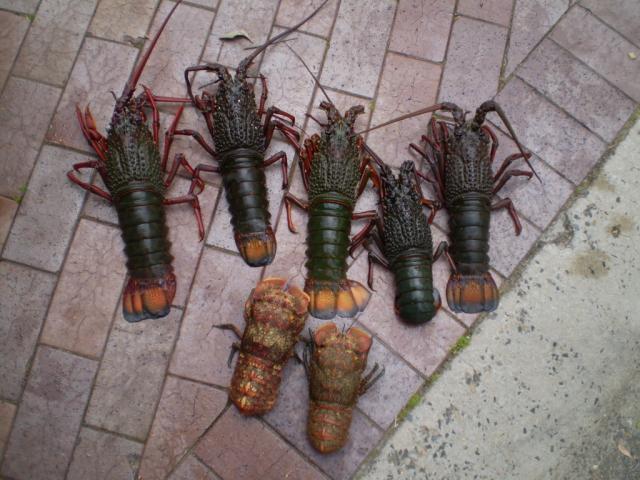
Lukaas, is there a commercial fishery in Australia for these creatures?
-
How do you communicate your love and in-depth knowledge of food to an audience without boring or alienating them?
Write about what you know and love in as few words as possible.
-
Our kitchen table is a 42" diameter circle that docks into the corner. The surface is not as nice as it used to be, so there's always a tablecloth. It gets changed almost every day and therefore nothing much can accumulate. Right now it has:
- an old oak lazy susan
- a cognac flask with water and fairly fresh lily-of-the-valley
- a plastic tub full of colorful cutlery from Ikea
- a large tube with blueprints
- a spent 9 volt battery
-
Are there "standards" for this? I want stock that I can use for anything from soups to sauces. I'd like to know what it is for chicken stock, as that's all I have ever made since having chicken parts on hand is a by-product of normal cooking for me. But I'd also like to get ratios for beef, veal, or any other sort of stock.
When I make stock I rarely know what it will be used for. Consequently, I'm very casual about how much of what goes in. That being said, I like the stock techniques from Le Cordon Bleu Complete Cook: Home Collection. For brown stock they suggest roasting 3 lbs beef marrow bones at 450F for 40 minutes, add 1 onion, 2 carrots, a leek and a celery stalk. Simmer for 3 hours in 4 quarts water, 2 T tomato paste, 1 bouquet garni and six peppercorns. Skim and strain, makes 8 cups.
Today I had no leeks, no tomato paste and no bouquet garni on hand so I went without. I added a bulb of garlic and intercepted one roasted bone before the water was added. The stock is now cooling in the fridge.

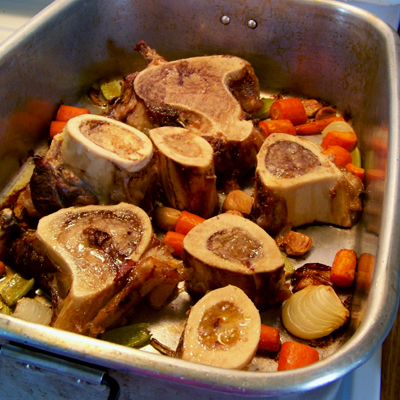
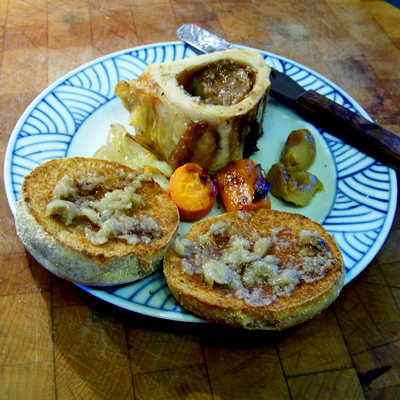
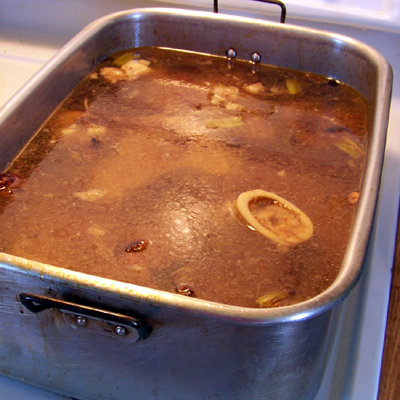
-
That's a very impressive way to enjoy lobster, thanks for sharing the thoughts and pictures. I'm glad to see such enthusiasm for Nova Scotia lobster, and to see that it's in good hands.
Clearwater is an excellent seafood vendor -- I shop at their Bedford store almost every week. They sell lobster year round based on size and hardness of shell, not by which Bay, Province or State from whence it came. If you ask, they will tell.
What makes the world's best lobsters? It's got something to do with cold, nutrient-rich waters and good timing. As far as I'm concerned, what you do with the live creature is paramount. Execute swiftly and do not over cook it.
-
I don't make blueberry pie simply because other people make them so much better than I ever could. I like a thin flaky golden crust and an equally thin layer of berries, preferably fresh wild blueberries.
-
Interesting topic -- I'm always freezing stuff on a stick for my kids. Right now we're into rhubarb/grapefruit.
My old college roommate worked in a Popsicle factory in southern Ontario, maybe Burlington? He related horror stories of crazy chemicals and rodent filth. Making your one is probably a good idea.
-
 2
2
-
-
Jumbo Lobster
A typical Nova Scotian lobster supper would feature a pound-and-a-quarter market-sized lobster boiled for fifteen minutes, served with melted garlic butter, a baked potato, corn on the cob and some cole slaw. If you're lucky there will be steamed mussels and fresh white buns. Popular accessories include a bib, scissors, a nutcracker and lobster pick. Some servers will pre-crack the claws for you and cut the underside of the tail for easier meat removal. There's really nothing inside the shell that can't be enjoyed -- oozy green tomalley, crumbly pink stuff, and of course the succulent white meat. For me, it's the sweet love child of a crab and shrimp.
A jumbo lobster weighs between four and ten pounds. The one seen below, until yesterday, lived in St. Margaret's Bay for ten or twelve years. She weighs in at just over four pounds and cost me twenty dollars. The box it came with could fit a pair of Kodiak work boots.
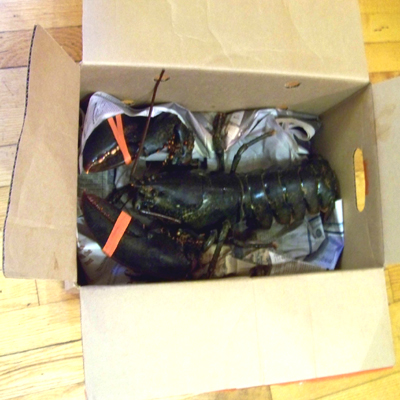
Cooking a large lobster presents a few problems. Without the double banded claws I'm sure it could take my finger off. Do I have a pot big enough? How do I cook through the body without over-doing the extremities?
I get two or three inches of water boiling in the big stock pot, then I stuff it in head first and keep my hand on the lid for five minutes. Move the lobster to a large cooking sheet and bust it up into pieces, cut the tail and body in half, then return to boiling water for another ten or fifteen minutes.


A nice bonus with the bigger lobsters is the leg meat -- it's worth the effort to crack one open and get a nice pencil-sized chunk. This lobster fed five people plus it provided the stock for an excellent chowder.
Lobster chunks on black squid ink noodles with vidalia white sauce, four kinds of mushrooms and steamed fiddleheads:
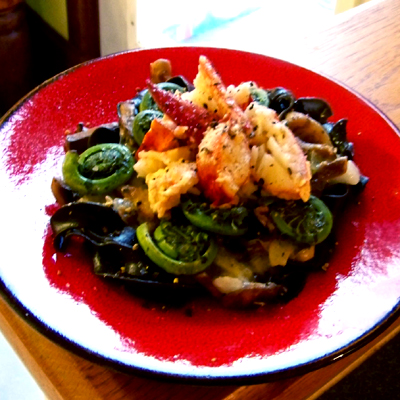



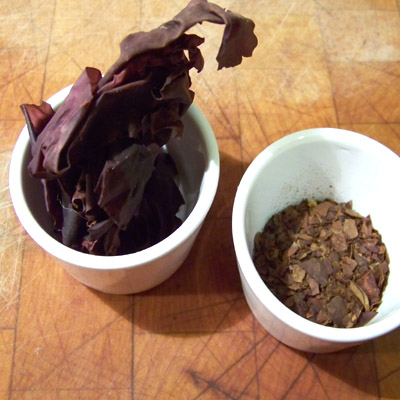
Electric Frying Pan / Skillet
in Cooking
Posted
I've got a 10 year old Sunbeam griddle which, coincidentally, is how long I've been married. It comes out for pancakes, grilled cheese and the multinomial egg-in-the-hole. My only complaint is that it heats unevenly -- you can see the shape of the heater through the cooking surface as things heat up.